| Home | Nature Weekly Index |
7 December 2014 | Blue Mud Dauber Wasp (Chalybion bengalense) |
I first noticed a small gang of wasps harbouring on an inflorescence of a sedge at around 5:45 am on Tuesday morning when I was watering my plants, a daily routine before I went to work. Sedge is a plant that looks very similar to a grass but they belong to different plant families. This particular sedge (Fimbristylis dichotoma) happened to be a resident in one of my pot along my balcony. Like many other residents, it sprang up spontaneously.
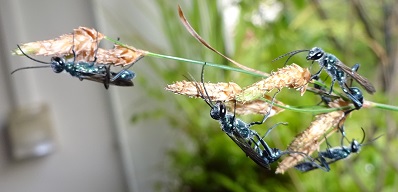
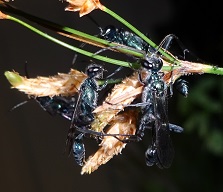 It was not the first time that I saw this
Blue Mud Dauber Wasp (Chalybion bengalense).
They are regular visitors to my balcony plants and seem to be always on the move, making it hard to get good pictures of them.
Their congregation in my home certainly was a rare opportunity for me to have a closer look at them, especially when they were taking
a nap.
It was not the first time that I saw this
Blue Mud Dauber Wasp (Chalybion bengalense).
They are regular visitors to my balcony plants and seem to be always on the move, making it hard to get good pictures of them.
Their congregation in my home certainly was a rare opportunity for me to have a closer look at them, especially when they were taking
a nap.
The wasps started to gather for the night around 6:30 pm. There were 4 of them when I first noticed their existence on Tuesday morning. On Thursday night, another fellow joined the gang. But, the number was down to two yesterday night. In the book titled "Sphecid wasps of the World, a generic revision" published in 1976 (page 102), it noted that Chalybion species commonly formed "sleeping" aggregations. Hence, such congregation for the night was not a new phenomenon. Nevertheless, I was glad to witness it first-hand.
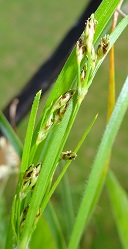
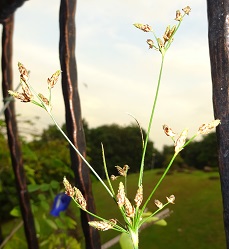
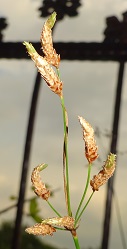 As this is a rather common sedge, I did not record when it started to grow in my pot but should be within the last few months.
Currently, it had 3 inflorescence; (1) a young one that was emerging, (2) a mature one that stood high and upright, and (3) an old
one that slant at about 45 degree toward the interior of the balcony. It was the old inflorescence that the wasps gathered. None
was seen on the upright inflorescence. Once the old inflorescence died, they might just disperse. Hopefully, they will migrate to
the other inflorescence. The wasps are more interested in spiders than human. Therefore, it is relatively safe to have them around.
There is now a good reason to keep the sedge though it does not look too attractive as a plant.
As this is a rather common sedge, I did not record when it started to grow in my pot but should be within the last few months.
Currently, it had 3 inflorescence; (1) a young one that was emerging, (2) a mature one that stood high and upright, and (3) an old
one that slant at about 45 degree toward the interior of the balcony. It was the old inflorescence that the wasps gathered. None
was seen on the upright inflorescence. Once the old inflorescence died, they might just disperse. Hopefully, they will migrate to
the other inflorescence. The wasps are more interested in spiders than human. Therefore, it is relatively safe to have them around.
There is now a good reason to keep the sedge though it does not look too attractive as a plant.
This was the second wasp that made use of my balcony's facilities. The earlier one was a solitary Delta pyriforme that built a mud nest on the stem of a plant located in a pot in May this year.